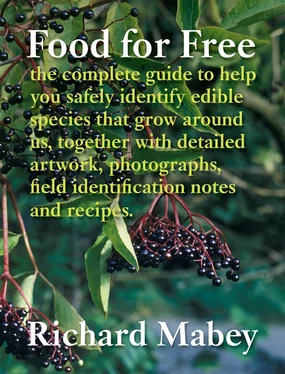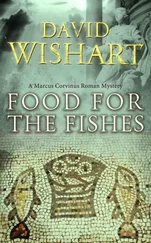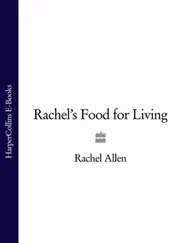Wild food and necessity
It is not easy to tell how wide a range of plants was eaten before agriculture began. The seeds of any number of species have been found in Neolithic settlements, but these may have already been under a primitive system of cultivation. Plants gathered from the wild would inevitably drop their seed and begin to grow near their pickers’ dwellings; and if, as was likely, the specimens collected were above average in size or yield, so might be their offspring. So a sort of automatic selection would have taken place, with crops of the more fruitful plants growing naturally near habitation.
By the Elizabethan era, the range of wild plants and herbs used and understood by the average cottager was wide and impressive. In many ways it had to be. There was no other source of readily available medicine, or of many fruits and vegetables. Yet even under conditions of necessity, how is one to explain the discovery that as cryptic a part as the styles of the saffron crocus was useful as a spice? The number of wild bits and pieces that must have been put to the test in the kitchen at one time or another is hair-raising. We should be thankful the job has been done for us.

© Mark Sisson/FLPA
Many plants passed into use as food at this time as a by-product of their medicinal use. Blackcurrants, for instance, were certainly used for throat lotions before the recipients realised they were also quite pleasant to eat when you were well. Sheer economy also played a part, as in finding a use for hop tops that had to be thinned out in the spring. But like so much else, these old skills and customs were eroded by industrialisation and the drift to the towns. The process was especially thorough in the case of wild foods because cultivation brought genuine advances in quality and abundance. But if the knowledge of how to use them was fading, the plants themselves continued to thrive. Most of them prospered as they had always done in woods and hedgerows. Those that flourished best in the human habitats bided their time under fields which had been turned over to cultivation, or moved into the new wasteland habitats that were a by-product of urbanisation. Plants which had been introduced as pot-herbs clung on at the edges of gardens, as persistent as weeds as they were once abundant as vegetables.
Then some crisis would strike the conventional food supplies, and people would be thankful for this persistence. On the island fringes of Britain, where the ground is poor and the weather unpredictably hostile, the tough native plants were the only invariably successful crops. The knowledge of how to use these plants as emergency rations was kept right up to the time air transport provided a reliable lifeline to the mainland.
It was the two World Wars, and the disruptions of food supplies that accompanied them, which provided one of the most striking examples of the usefulness of wild foods. All over occupied Europe fungi were gathered from woods, and wild greens from bomb sites. In America, pilots were given instructions on how to live off the wild in case their planes were ditched over land. And in this country, the government encouraged the ‘hedgerow harvest’ (as they called one of their publications) as much as the growing of carrots.
Wild plants are invaluable during times of famine or crisis, precisely because they are wild. They are quickly available, tough, resilient, resistant to disease, adapted to the climate and soil conditions. If they were not, they would have simply failed to survive. They are always there, waiting for their moment, thriving under conditions that our pampered cultivated plants would find intolerable.
Some modern agriculturalists are beginning to look seriously at the special qualities of wild food plants. Conventional agriculture works by taking an end food product as given, and modifying plants and conditions of growth to produce it as efficiently as possible. In regions that are vastly different from the plant’s natural environment, its survival is always precarious, and often at damaging expense to the soil and the natural environment. The alternative approach is to study the plants that grow naturally and luxuriantly in the area, and see what possible food products can be obtained from them. This should become an especially fruitful line of research in developing countries with poor soils.
Plant use and conservation
These last few instances are examples of conditions in which wild food use was anything but a frivolous pastime. I sincerely hope that this book will never be needed as a manual for that sort of situation. But is there really nothing more to gathering wild foods than the fun of the hunt, and the promise of some exotic new flavours? I think there is. Getting to know these plants and the uses that have been made of them is to begin to understand a whole section of our social history. The plants are a museum in themselves, hangovers from times when palates were less fastidious, living records of famines and changing fashions and even whole peoples. To know their history is to understand how intricately food is bound up with the whole pattern of our social lives. It is easy to forget this by the supermarket shelf, where the food is instantly and effortlessly available, and soil and labour seem part of another existence. We take our food for granted as we do our air and water, and all three are threatened as a result.
Yet familiarity with the ways of just a few of the plants in this book gives an insight at first hand into the complex and delicate relationships which plants have with their environment: their dependence on birds to carry their seeds, on animals to crop the grass that shuts out their light, on wind and sunshine and the balance of chemicals in the soil, and ultimately on our own good grace as to whether they survive at all. It is on the products, wild or cultivated, of this intricate network of forces that our food resources depend.
I know there may be some people who will object to this book on the grounds that it may encourage further depletions of our dwindling wildlife. I believe that the exact opposite is true. One of the major problems in conservation today is not how to keep people insulated from nature but how to help them engage more closely with it, so that they can appreciate its value and vulnerability, and the way its needs can be reconciled with those of humans. One of the most complex and intimate relationships which most of us can have with the natural environment is to eat it. I hope I am not overstating my case when I say that to follow this relationship through personally, from the search to the cooking pot, is a more practical lesson than most in the economics of the natural world. Far from encouraging rural vandalism, it helps deepen respect for the interdependence of all living things. At the very least it will provide a strong motive for looking after particular species and maybe individual ecosystems.
And maybe foraging can contribute even more, in today’s ecologically threatened world. If plants like wilding apples could contribute to the restoration of lost cultivated varieties, maybe, conversely, the restoration of cultivated land to wild, forageable land could build up new natural ecosystems. The possibility of the revival of a gentle communal use of such places would add foraging to the increasing range of community food initiatives, from organic food boxes to city farms.
Omissions
This book covers the majority of wild plant food products which can be obtained in the British Isles. But there are some categories which I have deliberately omitted.
• There is nothing on grasses and cereals. This is intended to be a practical book, and no one is going to spend their time hand-gathering enough wild seeds to make flour.
Читать дальше













